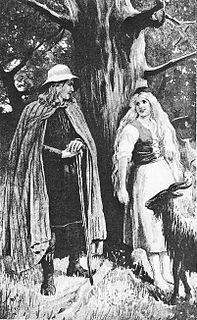Related Research Articles

Koizumi Yakumo, born Patrick Lafcadio Hearn, was a writer. He worked in the United States before moving to Japan and becoming Japanese. He was of Greek-Irish descent. He wrote about Japanese culture, especially his collections of legends and ghost stories, such as Kwaidan: Stories and Studies of Strange Things. In the United States, he is also known for his writings about New Orleans, based on his decade-long stay there.
Japanese folktales are an important cultural aspect of Japan. In commonplace usage, they signify a certain set of well-known classic tales, with a vague distinction of whether they fit the rigorous definition of "folktale" or not among various types of folklore. The admixed impostors are literate written pieces, dating back to the Muromachi period or even earlier times in the Middle Ages. These would not normally qualify for the English description "folktales".

A changeling, also historically referred to as an auf or oaf, is a human-like creature found in folklore and folk religion throughout Europe. A changeling was believed to be a fairy that had been left in place of a human stolen by the fairies.

Yamauba, Yamamba or Yamanba are variations on the name of a yōkai found in Japanese folklore.

Yuki-onna is a spirit or yōkai in Japanese folklore that is often depicted in Japanese literature, films, or animation.

Kwaidan is a 1965 Japanese anthology horror film directed by Masaki Kobayashi. It is based on stories from Lafcadio Hearn's collections of Japanese folk tales, mainly Kwaidan: Stories and Studies of Strange Things (1904), for which it is named. The film consists of four separate and unrelated stories. Kwaidan is an archaic transliteration of the term kaidan, meaning "ghost story". The film won the Special Jury Prize at the 1965 Cannes Film Festival, and received an Academy Award nomination for Best Foreign Language Film.

The Noppera-bō (のっぺらぼう), or faceless ghost, is a Japanese yōkai that looks like a human but has no face. They are sometimes mistakenly referred to as a mujina, an old Japanese word for a badger or raccoon dog. Although the mujina can assume the form of the other, noppera-bō are usually disguised as humans. Such creatures were thought to sometimes transform themselves into noppera-bō in order to frighten humans. Lafcadio Hearn used the animals' name as the title of his story about faceless monsters, probably resulting in the misused terminology.
"The Dream of a Summer Day" is an essay by Lafcadio Hearn that reminisced on his childhood, and which also incorporated a retelling of the Japanese folktale of Urashima Tarō. It was the first piece in the collection Out of the East (1895).

Shita-kiri Suzume, translated literally into "Tongue-Cut Sparrow", is a traditional Japanese fable telling of a kind old man, his avaricious wife and an injured sparrow. The story explores the effects of greed, friendship and jealousy on the characters.

"The Three Little Men in the Wood" or "The Three Little Gnomes in the Forest" is a German fairy tale collected in 1812 by the Brothers Grimm in Grimm's Fairy Tales. Andrew Lang included it in The Red Fairy Book (1890) as "The Three Dwarfs," and a version of the tale appears in A Book of Dwarfs (1964) by Ruth Manning-Sanders.
The Golden Crab is a Greek fairy tale collected as "Prinz Krebs" by Bernhard Schmidt in his Griechische Märchen, Sagen and Volkslieder. Andrew Lang included it in The Yellow Fairy Book.
The Armless Maiden is a Russian fairy tale collected by Alexander Afanasyev in Narodnye russkie skazki.
The Story of Zoulvisia is an Armenian fairy tale published in Hamov-Hotov, a collection of Armenian fairy tales by ethnologue and clergyman Karekin Servantsians published in 1884. Andrew Lang included it in The Olive Fairy Book. The story was also featured in the book Once Long Ago, by Roger Lancelyn Green and illustrated by Vojtech Kubasta.
Lovely Ilonka is a Hungarian fairy tale collected in Ungarische Märchen by Elisabet Róna-Sklarek. Andrew Lang included it in The Crimson Fairy Book.
The Little Green Frog is a French literary fairy tale, from the Cabinet des Fées. Andrew Lang included it in The Yellow Fairy Book.

The Funny Little Woman is a book "retold by" Arlene Mosel and illustrated by Blair Lent. Released by E. P. Dutton, it was the recipient of the Caldecott Medal for illustration in 1973.

"The Boy Who Drew Cats" is a Japanese fairy tale translated by Lafcadio Hearn, published in 1898, as number 23 of Hasegawa Takejirō's Japanese Fairy Tale Series. It was later included in Hearn's Japanese Fairy Tales.
Guerrino and the Savage Man is an Italian literary fairy tale written by Giovanni Francesco Straparola in The Facetious Nights of Straparola.

Incest is found in folklore and mythology in many countries and cultures in the world.

Hasegawa Takejirō was an innovative Japanese publisher specializing in books in European languages on Japanese subjects. Hasegawa employed leading foreign residents as translators and noted Japanese artists as illustrators, and became a leading purveyor of export books and publications for foreign residents in Japan.
References
- ↑ Lafcadio Hearn, Japanese Fairy Tales, "The Fountain of Youth"